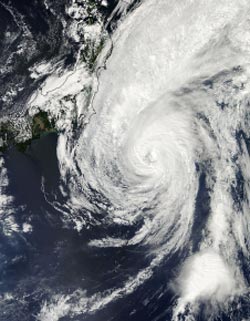NASA Views a Transitioning Tropical-Storm Pabuk

On Sept. 26, 2013 at 03:55 UTC/11:55 p.m. Sept. 25 EDT, the MODIS instrument aboard NASA's Aqua satellite captured this image of Tropical Storm Pabuk skirting eastern Japan. <br>Image Credit: NASA Goddard MODIS Rapid Response Team <br>
On Sept. 26, 2013 at 03:55 UTC/Sept. 25 at 11:55 p.m. EDT, the Moderate Resolution Imaging Spectroradiometer or MODIS instrument aboard NASA's Aqua satellite captured a visible image of Tropical Storm Pabuk skirting eastern Japan. MODIS imagery also showed a steady influx of cold air stratocumulus clouds into the low-level center of Pabuk, which was helping transition the storm.
On Sept. 26 at 1500 UTC/11 a.m. EDT, Extra-tropical storm Pabuk had maximum sustained winds near 60 knots/69 mph/111 kph. The center of Pabuk was located near 34.9 north and 146.7 east, about 441 nm south-southeast of Misawa, Japan. Pabuk continued to track to the northeast and has sped up to 25 knots/28.7 mph/46.3 kph per hour.
Satellite data revealed that Pabuk's low-level center has become elongated and more ragged on Sept. 26. The Joint Typhoon Warning Center noted that the entire tropical cyclone appears more asymmetrical and fragmented.
Pabuk is now part of a baroclinic cold air mass and is rapidly transforming into an extra-tropical cyclone. By the end of the day on Sept. 26, Pabuk is expected to be a cold core low pressure system over the open waters of the Northwestern Pacific Ocean, and the Joint Typhoon Warning Center issued its final advisory on Pabuk.
Text credit: Rob Gutro
NASA's Goddard Space Flight Center
Media Contact
All latest news from the category: Earth Sciences
Earth Sciences (also referred to as Geosciences), which deals with basic issues surrounding our planet, plays a vital role in the area of energy and raw materials supply.
Earth Sciences comprises subjects such as geology, geography, geological informatics, paleontology, mineralogy, petrography, crystallography, geophysics, geodesy, glaciology, cartography, photogrammetry, meteorology and seismology, early-warning systems, earthquake research and polar research.
Newest articles

Silicon Carbide Innovation Alliance to drive industrial-scale semiconductor work
Known for its ability to withstand extreme environments and high voltages, silicon carbide (SiC) is a semiconducting material made up of silicon and carbon atoms arranged into crystals that is…

New SPECT/CT technique shows impressive biomarker identification
…offers increased access for prostate cancer patients. A novel SPECT/CT acquisition method can accurately detect radiopharmaceutical biodistribution in a convenient manner for prostate cancer patients, opening the door for more…

How 3D printers can give robots a soft touch
Soft skin coverings and touch sensors have emerged as a promising feature for robots that are both safer and more intuitive for human interaction, but they are expensive and difficult…




















